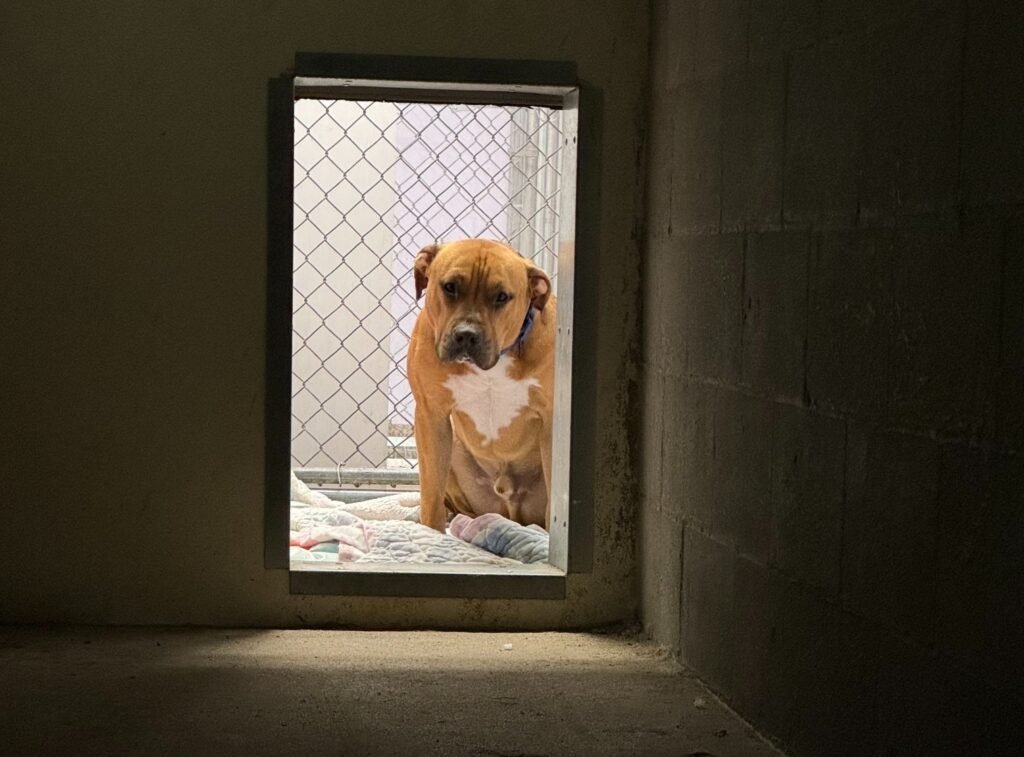Tyson didn’t arrive at the shelter broken—but somewhere between the first wag of his tail and his 128th day behind bars, something in him began to fade.
He had once been full of promise: a four-year-old pup with a gentle temperament, soft amber eyes, and an easygoing nature. But as weeks stretched into months at the Fulton County Regional SPCA in New York, Tyson’s spark began to dim. He stopped greeting volunteers with enthusiasm, no longer accepted treats with the same joy, and eventually refused to come out of his kennel at all. Instead, he paced in slow circles, head down, eyes hollow. The sound of barking, once background noise, now seemed to shake him.
“We were watching him shut down,” one volunteer shared. “He didn’t bark. He didn’t cry. He just waited—quietly—like he was giving up.”
One Photo, Thousands of Hearts

Knowing they were running out of time to reach him, the shelter shared a deeply emotional Facebook post, featuring a photo of Tyson looking somber and withdrawn. “This is what 128 days in a shelter looks like,” the post read, calling attention to the toll that long-term confinement was taking on this once-hopeful pup.
The image quickly struck a nerve. Within 48 hours, the post had been shared thousands of times. Messages poured in from across the country—some offering encouragement, others asking how they could help. Tyson had gone from overlooked to seen, thanks to one powerful photograph and a community of animal lovers who responded.
Local news stations soon picked up his story. Reporters visited the shelter, and Tyson, though nervous, faced the cameras alongside his favorite volunteer, Kelsey. She stayed by his side, offering gentle reassurance.
“He was extra brave,” the shelter wrote in a follow-up post. “He’s been through so much, but today he smiled for the first time in a long while.”
A Gentle Return to Hope
Even with the surge of attention, Tyson’s healing came slowly. Long-term shelter life can wear down even the kindest souls, and rebuilding trust takes time.
As staff at the Fulton County Regional SPCA shared in their Facebook post, “Our sweet Tyson is beginning to show signs of decline at the shelter. He is pacing in circles in his kennel, refusing to come outside – even for snacks.” It was a clear signal that shelter life was taking a toll on him, both mentally and emotionally.
Tyson’s quiet nature made his progress even more touching. He wasn’t loud or eager to impress—he simply waited, hoping someone would finally see past his sorrow.
The Smile That Said It All

It didn’t take long.
A family who had seen Tyson’s story on Facebook reached out, feeling drawn to the gentle dog so many had come to love online. After a few careful visits, the connection was clear. Tyson, cautious but willing, leaned into them with his full weight during their last meeting.
“He curled up next to them and sighed,” said one staff member. “That’s when we knew—he was ready.”
Now, Tyson is home. The shelter later shared a final image: Tyson curled up on a couch, fast asleep, a soft smile on his face. The caption read simply: “He’s finally at peace.”
The Power of Being Seen

Tyson’s story is proof that even the quietest cries for help can be answered when the right people are listening.
Thanks to the unwavering dedication of shelter staff, the thousands who shared his Facebook post, and one family who decided he was worth the wait, Tyson has the life he always deserved. But his story is just one among many.
Every shelter has a Tyson. And sometimes, all it takes is a post, a share, and a little hope to change everything.







